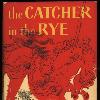

Tags: The Catcher In The Rye View |
The Catcher In The Rye by J D Salinger Tags: Catcher In The Rye, The Catcher In The Rye View |
No Sequel for Catcher in the Rye J D Salinger 90 year old author of Catcher in the Rye is suing Swedish author Fredrik Colting for copyright infringement for his recent novel 60 Years Later Coming Through the Rye A U S Tags: Catcher In The Rye, The Catcher In The Rye View |
|||||||||
The Catcher in the Rye is a 1951 (1951 in literature) novel by the late J. D. Salinger. Originally published for adults, it has since become popular with adolescent readers for its themes of teenage confusion, angst, sexuality (human sexuality), alienation, and rebellion. It has been translated into almost all of the worlds major languages (world language). Around 250,000 copies are sold each year, with total sales of more than sixty-five million. The novels protagonist and antihero, Holden Caulfield, has become an icon for teenage rebellion.
The novel was included on a 2005 Time Magazine (Time (magazine)) list of the 100 best English-language novels written since 1923, and it was named by Modern Library and its readers as one of the 100 best English-language novels of the 20th century (Modern Library 100 Best Novels). It has been frequently challenged (List of most-commonly challenged books in the United States) in the United States for its liberal use of profanity and portrayal of sexuality (Human sexuality) and teenage (Adolescence) angst. It also deals with complex issues of identity (Identity (social science)), belonging, connection, and alienation.
Holden shares encounters he has had with students and faculty of Pencey, whom he criticizes as being superficial, or, as he would say, "phony", Holdens ultimate insult for anything. After being expelled from the school for poor grades, Holden packs up and leaves the school in the middle of the night after an altercation with his roommate. He takes a train to New York, but does not want to return to his family and instead checks into the dilapidated Edmont Hotel. There, he spends an evening dancing with three tourist girls and has a clumsy encounter with a prostitute; his attitude toward the prostitute (a girl his own age) changes the minute she enters the room, and after he tells her he just wants to talk, she becomes annoyed with him and leaves. However, he still pays her for her time. She demands more money than was originally agreed upon and when Holden refuses to pay he is beaten by her pimp, Maurice (despite her encouraging him to simply threaten the money out of him and leave).
Holden spends a total of three days in the city, characterized largely by drunkenness and loneliness. At one point he ends up at a museum, where he contrasts his life with the statues of Eskimos on display. For as long as he can remember, the statues have been unchanging. These concerns may have stemmed largely from the death of his brother, Allie. Eventually, he sneaks into his parents apartment while they are away, to visit his younger sister, Phoebe, who is nearly the only person with whom he seems to be able to communicate. Phoebe views Holden as a hero, and she is naively unaware that Holdens view of her is virtually identical. Holden shares a fantasy he has been thinking about (based on a mishearing of Robert Burns Comin Through the Rye): he pictures himself as the sole guardian of numerous children running and playing in a huge rye field on the edge of a cliff. His job is to catch the children if they wander close to the brink; to be a "catcher in the rye".
After leaving his parents apartment, Holden then drops by to see a former, and much admired, English teacher, Mr. Antolini, in the middle of the night, and is offered advice on life and a place to sleep. Mr. Antolini tells Holden that it is the stronger man who lives humbly, rather than dies nobly, for a cause. This rebukes Holdens ideas of becoming a "catcher in the rye," a heroic figure who symbolically saves children from "falling off a crazy cliff" and being exposed to the evils of adulthood. During the speech on life, Mr. Antolini has a number of "highballs," referring to a cocktail served in a highball glass. Holdens comfort is upset when he wakes up in the night to find Mr. Antolini patting his head in a way that he perceives as "flitty." There is much speculation on whether Mr. Antolini was making a sexual advance on Holden, and it is left up to the reader to decide whether this is true. Holden leaves and spends his last afternoon wandering the city. He later wonders if his interpretation of Mr. Antolinis actions was actually correct.
Holden decides to move out west; he relays these plans to his sister, who decides she wants to go with him. He refuses to take her, and when she becomes upset with him, he tells her that he will no longer go. Holden then takes Phoebe to the Central Park Zoo, where he watches with a bittersweet joy as she rides a carousel. He decides, while watching Phoebe, to go home and "face the music". At the close of the book, Holden chooses not to mention much about the present day, finding it inconsequential. He alludes to "getting sick" and living in a mental hospital (Psychiatric hospital), and mentions that hell be attending another school in September. Holden says that he has surprisingly found himself missing Stradlater and Ackley (his former classmates), and even Maurice the elevator operator/pimp. He says, "Dont ever tell anybody anything. If you do, youll start missing everybody".
Author: J. D. Salinger
Language: English
Genre: Novel
Publisher: Little, Brown and Company
Release Date: 1951
Media Type: Print (Hardback (Hardcover) & Paperback)
Pages: 276 pp
Isbn: 0-316-76953-3
Oclc: 287628



